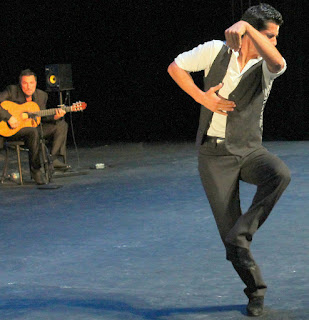 |
| Olga Pericet |
Albuquerque provides a
great backdrop to visit the festival, with plenty of museums (consider the Anderson-Abruzzo International Balloon
Museum), chili topped food (El Pinto
is terrific) and plenty of culturally significant things to see and do
(consider visiting the Acoma Pueblo
– the oldest continuously inhabited settlement in North America). Evening
performances run every night of the festival, and by day hundreds of eager
dancers, some novices, some seasoned, some perhaps rusty, don tattered clothes
and fill the Carlisle Gym on the University
of New Mexico campus, just off historic Route 66 to dance their way into a shared visceral experience.
Understanding Flamenco
Flamenco is probably the
most versatile and multi-faceted dance there is. It is at once a dance and a
synthesis of music, including dancers and musicians. But Flamenco is also
playful; dancers interact with the audience, and with the others on stage;
truly a collaborative effort. Obviously the dance is the focal point, but there
is singing, the guitar and the palmas
(rhythmic clapping) - layers of artistry at work, each contributing to the
overall experience. And Flamenco also has a diversity of styles, from
traditional to modern stylistic approaches with elements of improvisation. The
word you hear most often associated with Flamenco is “passion.” But the
liberating aspects of Flamenco are more than passion, they are primal, eternal,
and they are timeless. I need to mention about the singing, as some people
don’t understand it. There is often a sorrow in the singing, which translates
to an almost crying when you hear it, a sad convulsing type of sound.
There are no traditional
“strong male/weak female” roles as you see in other dances. What I love about Flamenco
is that there is confidence and assertiveness, sexuality and sensuality by both
men and women. Group dances of necessity are choreographed, but solo and duo
performances contain plenty of improvisation. An example of this was when renowned
dancer Adela Campallo lost her hair
clip during a frenzied moment at the 2012 festival. Realizing it was dead
center on stage, (the audience too was keenly aware) she gracefully maneuvered
herself into position, picked it up, incorporated it into her dance and put it
back in her hair without breaking her staccato movement, and to the thunderous
applause of the audience. Solo performances like hers can run as long as 20
minutes, a physical challenge for any dancer and a drain on legs and feet,
however the complete submersion into the dance, the near hypnotic dedication is
fascinating to watch.
 |
| Alfonso Losa |
Learning Flamenco
Joaquin Encinias, Associate Director of the National Institute of
Flamenco, started dancing when he was four. During the festival he teaches
classes including one for beginners, showing them the basics, offering the most
comprehensive method of Flamenco instruction in the country. “Flamenco is the
study of music, nuance and culture as much as it is a study of movement,” he
tells me during a break. “It’s a deeper experience that I think a lot of
Americans are starving for,” he says. Ricardo
Anglada has been teaching guitar for four years at the festival and tells
me that the guitar, though now the primary musical instrument, was introduced
to Flamenco after singing and palmas made their way into the dance. “That’s the
beauty of Flamenco, it’s always changing and it adapts to other styles,” he
says. “Flamenco today is more versed in musical variations, incorporating elements
of jazz and blues,” he tells me. And this was clearly evidenced on stage, where
there is a freedom of musical expressions. But mainly people come to see and
feel the dancing which is both fluid and staccato, aggressive and graceful,
powerful yet lyrical. And the beauty of the festival is that it allows anyone
to learn. When I mention to one teacher that I’m a middle aged, slightly
heavy-set male who is enthusiastically intrigued by Flamenco, she interrupts
me. “You’re never too old and never too heavy,” she retorts. “I’ve seen heavy gypsies’
who will amaze you.” (I guess that was something of a compliment.)
Perhaps Flamenco is
beckoning you. Perhaps you see in the dance a longing reflected in your own
soul. And then, who knows, you might find yourself in Albuquerque at the
Carlisle Gym with dancers from across the globe exploring an art form as old as
time and as vibrant as today. National Institute of Flamenco
Check out my exclusive video I shot at one of the performances. Cameras are not allowed during performances, though I was permitted to film. This 6 minute video is a rare chance to see what you’re missing:Exclusive Highlights of the Albuquerque Flamenco Festival
Check out my exclusive video I shot at one of the performances. Cameras are not allowed during performances, though I was permitted to film. This 6 minute video is a rare chance to see what you’re missing:Exclusive Highlights of the Albuquerque Flamenco Festival




No comments:
Post a Comment